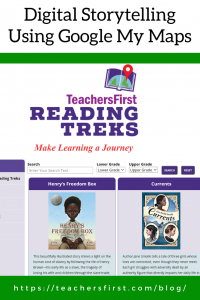“Storytelling is the Oldest Form of Education”
Terry Tempest Williams
How do you incorporate digital storytelling into your classroom? This article written by Anna Warfield discusses the 6 Reasons You Should Be Doing Digital Storytelling With Your Students. The author discusses the benefits of digital storytelling, including integrating technology with the writing process, critical thinking skills within the decision-making process, and the use of digital storytelling applications for assessment. The article provides a great deal of information supporting the benefits of digital storytelling.
Perhaps you are familiar with TeachersFirst Reading Treks. Reading Treks use Google My Maps (TeachersFirst review) to share virtual field trips based on literature. A Reading Trek takes users on an immersive journey beyond the written word, expanding the reading experience through digital storytelling using maps, text, and images. This digital storytelling method provides an engaging and robust teaching tool for classroom use.
As you work with digital storytelling, it is critical to understand the essential elements of effective stories. The University of Houston Education Department shares The 7 Elements of Digital Storytelling as a starting point. Let’s use these elements to look at the components of one of our recent Reading Treks, Henry’s Freedom Box. This book tells the story of Henry Brown and his journey to escape from slavery while traveling by wagon, train, and steamship in a box for over 72 hours.
- Point of View: The teacher’s guide for Henry’s Freedom Box shares ideas for classroom use. One suggestion recommends that students compare and contrast the daily lives of Henry and James. James is described by other sources describe as a “free” man.
- Dramatic Question: Students define and discuss terms the freedom, rights, and responsibility as a whole class. The Reading Trek provides younger and older students with options by creating digital word clouds.
- Emotional Content: There are many opportunities to include emotional content when incorporating digital storytelling in this book. Students put themselves into Henry’s shoes by considering what it would be like to travel for 24 hours in a cramped place. They share what items they would bring, what would have to be left behind, and why this type of journey is necessary.
- The Gift of Your Voice: Creating a story using Google My Maps allows the creator to tell the story through their voice and their choices for items to include. Find opportunities for sharing the gift of voice within activities in this Reading Trek. As students begin their virtual field trip through the book, they discuss the demographics of their classroom and school to define their personal and social identity, helping students understand the voice and experiences that they bring to the reading of this story and understand the characters’ experiences.
- The Power of Soundtrack: Unfortunately, Google My Maps doesn’t provide an option for adding a soundtrack to a digital story; however, it is possible to include sounds by offering links to audio recordings or videos. This Reading Trek is a link to a video entitled One Nobel Journey: A Box Marked Freedom. This video includes an actor’s portrayal of the first portion of Henry’s journey.
- Economy: Economy in digital storytelling refers to the amount of content included with the digital story. It should be enough to tell the story without being overwhelming. The use of economy also refers to the original article about the reasons for using digital storytelling; creators decide what to include that meets their storytelling goals. For example, in this Reading Trek, the creator made deliberate choices on what to share on the map to show locations of Henry’s journey along with links that provide supplemental information for the map’s users.
- Pacing: Good stories have a rhythm that changes as events unfold. Using Google My Maps offers the opportunity to follow at an individual pace. Users view the map and choose places and links to explore at their own pace. Use the layers found on the map to enhance comprehension of characters, places, and events.
TeachersFirst Reading Treks offer many different ready-to-go virtual field trips for classroom use, but what if you want to create your own? This archived recording from a November 2021 OK2Ask virtual workshop provides step-by-step instructions on getting started with Google My Maps. Additional helpful resources are available at the learning session’s resource site. Google My Maps is an excellent digital storytelling alternative to written book reports or research papers if you teach older students.
Incorporating maps into digital storytelling projects allows us to use visuals as part of the storytelling process. Adding a tool like Google My Maps takes the use of maps a step further by offering the opportunity to share information in new ways. Consider incorporating digital storytelling into your classroom activities to provide students with valuable digital and storytelling experiences.
How do you incorporate digital storytelling in your classroom? Perhaps you have suggestions or tips to share with our readers. Please share them in the comments below!


